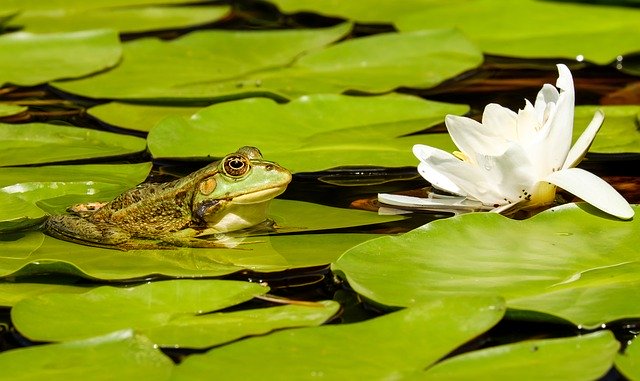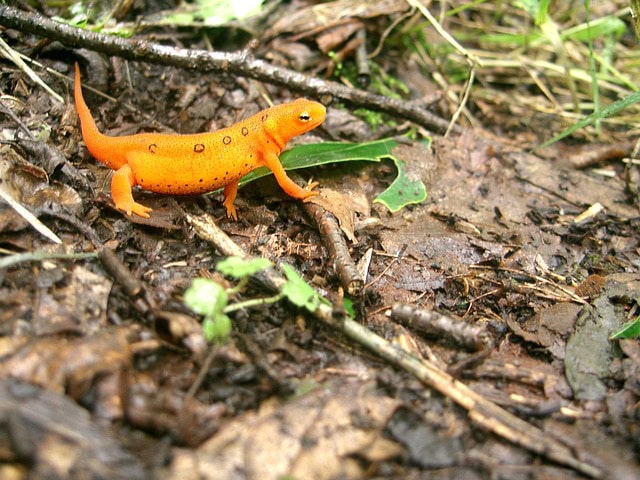Why should we care about declining amphibian populations?
Amphibians are a diverse group of vertebrates with more than 6,500 unique species. In New York State, there are 32 described amphibian species that occur naturally. This is a significant number of species for a temperate climate. However of the 32 species, 9 species are listed as either endangered, threatened or special concern by the NYS Department of Environmental Conservation, with 2 more species listed as high priority.

American bullfrog (Lithobates catesbeianus)
My memories of Teatown during the summer are filled with catching frogs and flipping logs to uncover salamanders. Discovering amphibians was a big part of my Teatown experience as a camper. Over the years I’ve developed a great interest in these small creatures that brought so much joy to me as a child.
Amphibians are a diverse group of vertebrates with more than 6,500 unique species. However, new species are being discovered each year. The stump-toed frog (Stumpffia troschaueri) in Madagascar, the Hickory Nut Gorge green salamander (Aneides caryaensis) in North Carolina, the South China giant salamander (Andrias sligoi) in China, a species of narrow-mouthed frog (Microhyla eos) in India and the Muduga leaping frog (Walkerana muduga) also in India, have all been described in scientific journals within the past year.
Despite the ongoing discoveries, global amphibian populations are declining at an alarming rate. More species are presumed extinct each year than are discovered. A new study¹ suggests that amphibians are dying off so quickly, they could disappear from half their habitats within the next 20 years. Another study² showed that as populations decline, biodiversity drops and homogeneous communities emerge. The culprit: human activity.
Scientists are still in the early stages of understanding how different factors are influencing amphibian populations. Among the many factors being studied are habitat loss, climate change, over-exploitation, car mortality, pollution, and disease. These factors are well studied on their effects on populations and have been identified as threats, however analysis of large scale risk to amphibians has not been emphasized in research.

The red eft, the juvenile stage of an eastern newt (Notophthalmus viridescens)
Why should we care so much about declining amphibian populations? Amphibians have semi-permeable skin that allows for easy absorption of oxygen and water, but also toxins. Often amphibians act as an eco-indicator, giving scientists a look at water quality. pH levels (especially acidification), nitrate and nitrite levels, pharmaceuticals, road salt and other toxic substances all contribute to population decline. UV radiation from depleted ozone may affect amphibians during their egg and larvae life stages. This radiation is also bad for human health. As part of the ecosystem community, amphibians fill an important role as predators. Of note are frogs’ predatory preference for mosquitoes. Salamanders predate on invertebrates in the soil and under the leaf litter. This indirectly affects the amount of litter available for soil-building.
In New York State, there are 32 described amphibian species that occur naturally. This is a significant number of species for a temperate climate. However of the 32 species, 9 species are listed as either endangered, threatened or special concern by the NYS Department of Environmental Conservation and 2 more species are listed as high priority. That is about a third of amphibian species in NYS. It is important we recognize how our impacts on animals like amphibians affect us as humans. I can’t imagine a place like Teatown without the diversity of amphibians from my childhood summers.
References
¹ Adams MJ, Miller DAW, Muths E, Corn PS, Grant EHC, Bailey LL, et al. (2013) Trends in Amphibian Occupancy in the United States. PLoS ONE 8(5): e64347.
² Nowakowski AJ, Frishkoff LO, Thompson ME, Smith TM, Todd BD (2018) Phylogenetic homogenization of amphibian assemblages in human-altered habitats across the globe. Proc Natl Acad Sci USA 115:E3454–E3462.

About the Author
Elissa Schilmeister, Environmental Educator and Volunteer Coordinator
Elissa is a home grown Teatowner, starting as a camper, and going on to be a camp counselor, volunteer, and now staff. Elissa is also a NYS licensed wildlife rehabilitator and EMT.


Leave a Reply